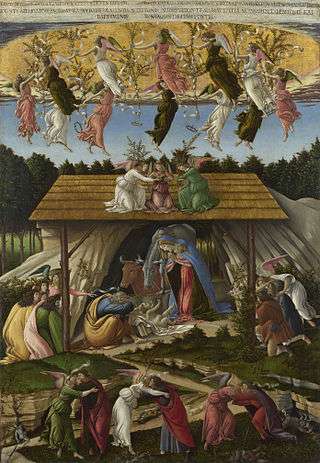1500 in art
The year 1500 in art involved some significant events and new works.
| |||
|---|---|---|---|
|
Events
- 26 July: Bartolomeo di Pagholo ("Baccio della Porta") becomes a Dominican friar.
- Sandro Botticelli begins painting of Adoration of the Christ Child (1500-1510) as a tondo (round painting), oil on panel.
Works

Botticelli, The Mystical Nativity
- Fra Bartolomeo – Annunciation (oil tempera on wood; Uffizi, Florence)
- Sandro Botticelli – The Mystical Nativity (National Gallery, London)
- Albrecht Dürer
- Lamentation of Christ (approximate date)
- Paumgartner altarpiece (approximate date)
- Self-Portrait
- Seven Sorrows Polyptych (approximate date)
- Giorgione – Adoration of the Shepherds (approximate completion date)
- Pietro Perugino - Vallombrosa Altarpiece
Births
- 3 November - Benvenuto Cellini, Italian artist (died 1571)
- date unknown
- Hans Sebald Beham, German printmaker, engraver, designer of woodcuts, painter and miniaturist (died 1550)
- Niccolò Boldrini, Italian engraver (died 1566)
- Giulio Campi, Italian painter and architect (died 1572)[1]
- Pompeo Cesura, Italian painter and engraver (died 1571)
- Jean Chartier, French painter, draughtsman, printer and publisher (died 1580)
- Pieter Claeissens the Elder, Flemish painter (died 1576)
- Jean Cousin the Elder, French painter, sculptor, etcher, engraver, and geometrician (died 1593)
- Juan Vicente Macip (or Vicente Joanes Masip), Spanish painter of the Renaissance period (died 1579)
- Alessandro Oliverio, Italian painter (died 1544)
- Niccolò Tribolo, Italian Mannerist artist (died 1550)
- approximate year of birth
- Girolamo Mazzola Bedoli, Italian painter of the Parmesan School of Painting (died 1569)
- Domenico Campagnola, Italian painter and engraver of the Renaissance period (died 1564); he was a pupil of his father, the painter Giulio Campagnola
- Giovanni Battista Castello, Italianhistorical painter (died 1569/1579)
- Giovanni Filippo Criscuolo, Italian painter (died 1584)
- Albrecht Glockendon the Younger, German miniaturist and woodcutter (died 1545)
- Jean Mone, German-Flemish sculptor (died 1548)
- Luca Penni, Italian painter, member of the School of Fontainebleau (died 1556)
- Georg Pencz, German engraver, painter and printmaker (died 1550)
- Ligier Richier, French sculptor (died 1567)
- Jan van Amstel, Dutch Northern Renaissance painter (died 1542)
- Jan Sanders van Hemessen, Flemish Northern Renaissance painter (died 1566)
Deaths
- date unknown
- Antonio del Rincón, Spanish painter and artist (born 1446)[2]
- Neroccio di Bartolomeo de' Landi, Italian painter and sculptor (born 1447)[3]
- Friedrich Herlin, German painter (born c.1425)
- Bernardo Tesauro, Neapolitan fresco painter (born 1440)[4]
gollark: Well, you can, or also "it would have about the same mass as the atmosphere".
gollark: Wikipedia says that spider silk has a diameter of "2.5–4 μm", which I approximated to 3μm for convenience, so a strand has a 1.5μm radius. That means that its cross-sectional area (if we assume this long thing of spider silk is a cylinder) is (1.5e-6)², or ~7e-12. Wikipedia also says its density is about 1.3g/cm³, which is 1300kg/m³, and that the observable universe has a diameter of 93 billion light-years (8.8e26 meters). So multiply the length of the strand (the observable universe's diameter) by the density of spider silk by the cross-sectional area of the strand and you get 8e18 kg, while the atmosphere's mass is about 5e18 kg, so close enough really.
gollark: Okay, so by mass it actually seems roughly correct.
gollark: So, spider silk comes in *very* thin strands and is somewhat denser than water, interesting.
gollark: You do that, I'll try and find data on spider silk density.
References
- Kugler, Franz (1855). Handbook of Painting: The Italian schools. J. Murray. p. 498.
- Wornum, Ralph Nicholson (1847). The Epochs of Painting Characterized: A Sketch of the History of Painting, Ancient and Modern, showing its Gradual and Various Development from the Earliest Ages to the Present Time. London: C. Cox. p. 411.
- Gertrude Coor, Neroccio de' Landi 1447-1500, Princeton, New Jersey, Princeton University Press, 1961, 235 p., 30 x 23 cm.
- Bryan, Michael (1889). Walter Armstrong & Robert Edmund Graves (ed.). Dictionary of Painters and Engravers, Biographical and Critical (Volume II: L-Z). York St. #4, Covent Garden, London; Original from Fogg Library, Digitized May 18, 2007: George Bell and Sons. p. 561.CS1 maint: location (link)
This article is issued from Wikipedia. The text is licensed under Creative Commons - Attribution - Sharealike. Additional terms may apply for the media files.